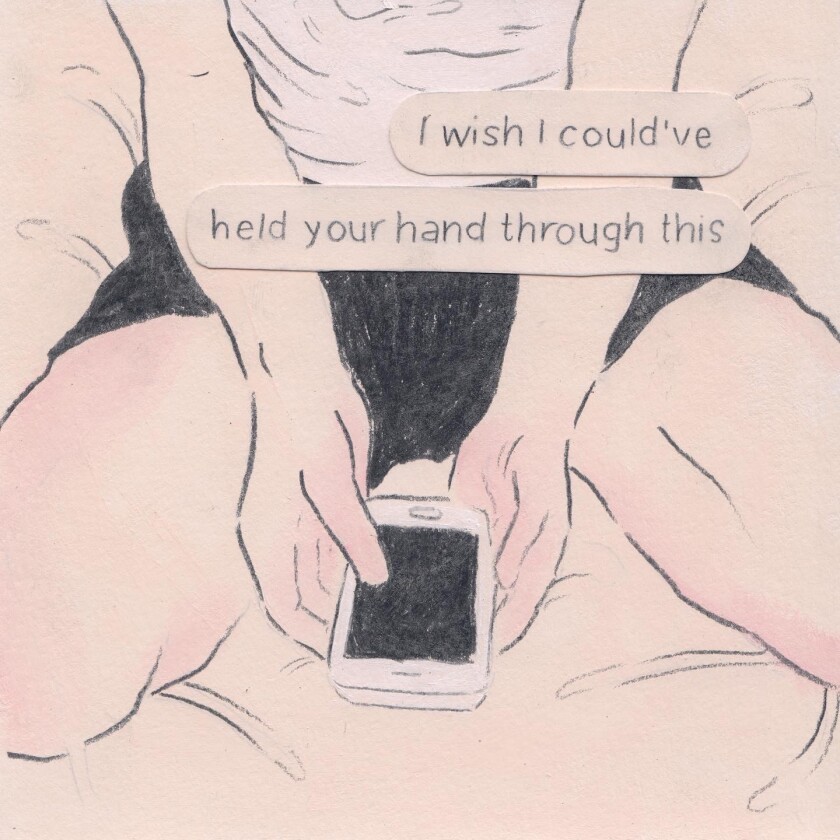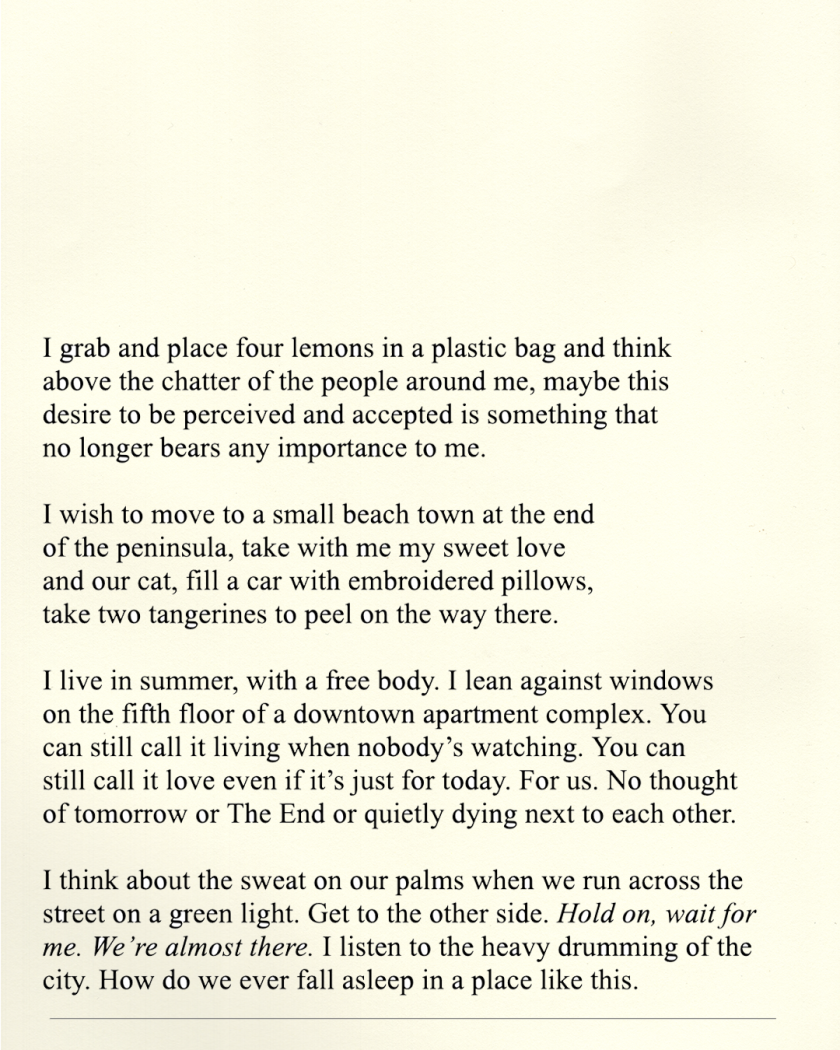Where to Buy Beer Arts or Pictures in San Diego Ca
The work of Andrés Hernández deals, perhaps above all else, in the act of longing.
The want for a lover's touch that has long been absent. The conceptual feeling of wanting to be understood and accepted. The seemingly inescapable boundaries of borders, both physical and metaphorical.
Think of the music of those notes that singers like Sade or Juan Gabriel can hitting. Remember the words of Sylvia Plath and Pablo Neruda. Call up the strokes within paintings such every bit Andrew Wyeth's "Christina'south Earth" and John Singer Sargent's "Secret Muse."
That kind of longing.
"I like to think if each project equally its own encapsulation of whatever I'yard going through at the time," says Hernández from Hill Street Country Club, where the nonbinary/genderqueer creative person recently wrapped up a solo exhibition of analogue photography and collage entitled, appropriately enough, "Crying on the Blue Trolley Line."

(Bill Wechter/For The San Diego Union-Tribune)
The title of the exhibition is meant to convey these feelings, every bit it refers to the trolley line that connects San Diego to the border of Tijuana. Walk into Hill Street Country Club (HSCC) at a certain time of day, and in a certain mood, and the viewer will find themselves feeling enveloped by the pictures. The pictures themselves are a mix of photography of structures, walls and overpasses along the San Diego/Tijuana border that Hernández snapped and then re-rendered into moody, atmospheric and sometimes stark statements on love and being.
To hear Hernández tell it, she didn't program on using the photos for this type of exhibition at all. She had originally planned on using them simply as examination shots for her fist solo painting exhibition at HSCC. With dispensable cameras in hand, Hernández says she began taking hundreds of test shots around places such equally Tijuana River Estuary and the bridges and tunnels around the border; places she establish to exist representative of the binational experience and one where a cross-border relationship can be difficult to navigate.
"When I was start asked to practise a show, I wanted to exercise something completely unlike," Hernández recalls. "I thought I would do a series of landscape paintings. Blurry paintings of landscapes depicting the border region and the journey you accept looking at these concrete structures along the edge."
"I didn't really know that I wanted to practice photography until one morn, talking to my partner, Neville, and I said that I didn't retrieve I wanted to do painting anymore," Hernández continues. "I think I want to do photographs and combine the photos of the bridges that I accept with the border wall in a way that is not noticeable. I just woke upwardly with that idea and information technology felt so natural and organic."

Creative person Andres Hernandez with some of her work at Hill Street Country Club gallery in Oceanside on Friday, March 18. The framed photograph at right is called "Untitled."
(Bill Wechter/For The San Diego Marriage-Tribune)
This type of "organic" feeling tin can also be found in "we used to move through the city like doves in the air current," a gorgeously vulnerable graphic novel that recounts Hernández'southward experiences during the COVID-19 pandemic. Separated from Neville, who lives in San Diego, when the border was shut down, Hernández gently recounts the feelings of isolation and displacement she felt during this time. With its gorgeous acrylic-and-pencil illustrations and text — some of which is taken directly from text messages, voice notes and Hernández's own journal — "we used to movement…" is a voyeuristically poetic account of the pandemic feel and one made all the more than uniquely profound by the fact that Hernández was separated from her partner by an uncrossable border.
"It sometimes takes me off guard, the fact that I have to share stuff with people and sometimes explain my piece of work" Hernández says. "Merely talking virtually it, that's when it really hits me. When I'one thousand making information technology, it's but for myself."

(Andrés Hernández)
"We used to motion …" also recounts these experiences from both the perspective of Hernández as well every bit her partner'southward experiences being a person of color in San Diego.
"I e'er want to include as many perspectives as possible, but I don't desire to make a narrative nearly things that don't necessarily affect me," Hernández says.
"At first I didn't intend on writing it that way," Hernández continues. "But after finishing the kickoff draft, I knew information technology wasn't going to be complete until I had his experiences as well. I began to like the concept of having ii parts to the story and having the border be representative of the halfway carve up point between those ii stories."
Born and raised in Tijuana, Hernández struggled growing up. She often likes to tell an anecdote most finding her creative spirit subsequently a doctor told her that she wasn't allowed to beverage milk anymore and drawing a cup of hot chocolate with a sorry face.
"I retrieve I tell that story considering it's funny to me that I notwithstanding remember that," Hernández says. "But I basically just drew everything. I drew when my dog died, like as angels and stuff. The milk thing was just one of those beginning instances that I remember."
Hernández often found herself feeling like an outsider a lot growing up in Playas de Tijuana. Living as a nonbinary person tin be tough wherever someone is raised, but Mexican culture, which can be steeped in conservative Catholicism and rigid gender roles, can be peculiarly tough. Hernández says she found comfort in literature and fairy tales, which helped her tap into a world that wasn't as structurally binary.
"I would exercise things similar change endings just for fun," Hernández says. "Information technology's office of escapism, just escaping my limited environment and trying to discover a world where I could just feel like myself; a place where the things that were going on in my head weren't that impossible anymore."

(Andrés Hernández)
Notwithstanding, Hernández adds that she stopped doing fine art throughout much of high school and didn't take information technology seriously considering her family was pressuring her to choice a career path that was more "realistic." She says she understands where her family unit was coming from and concluded up studying communications when it was time to go to college. Fifty-fifty there, even so, Hernández says her listen was still filled with ideas of things she wanted to brand.
"I felt really afraid to even ask my parents to buy me art supplies, because my parents were like, 'do not go into that,'" Hernández recalls, calculation that information technology wasn't until she got a job instruction English language at a language school and making her own money that she felt comfortable doing art again. "To me, there was this great fear of creating annihilation."
One of the moments that broke this fear was when, in 2016, Hernández, who was 19 at the time, was accepted to a volunteer program to work and live in Hamburg, Germany. She says the chore was draining and she often felt lone, but it was there where she really felt free to explore local museums — and her sexuality. She came back to North America with a newfound sense of purpose and began to accept her fine art more seriously. A lot of her early piece of work, which included everything from acrylic paintings to poetry readings, dealt in themes such as polyamory, toxicity and her work at maquiladora factories in Mexico.
"I've ever written, but for me, everything comes with images, just it wasn't until I began feeling these emotions that I couldn't contain and only looked like comics in my head," Hernández says. "I didn't abound up a fan of comics and even now, I don't know if I like to call them comics. I telephone call them vignettes or illustrations, documenting my relationships and how those relationships are afflicted by the border."

(Andrés Hernández)
Hernández plans on exporting this further with her adjacent project, a series of self-portraits exploring her ain gender journey and identity. She plans on using the aforementioned photograph-and-collage processes she used for the images at HSCC.
"I want to explore the women in my family, and how women have been perceived throughout Mexican history and in the culture," said Hernández, who plans on working on this concept at an artist residency at the Breadstuff & Salt art space in Logan Heights in August. "How that has become a extravaganza of sorts in the U.South."
Whatever medium Hernández settles on, she agrees that her work volition continue to explore that longing that every artist feels. She agrees that a common electric current throughout her work is a striving for contentment. And while she is notwithstanding a young artist, the themes that she explores in her work are universal. Whether it'south a longing for a lover or a longing for inner peace, Hernández taps into an unspoken dialogue within, forcing viewers to face up issues both unrequited and unresolved. The deviation here is that she has plant the backbone to explore it.
"I feel like I exercise all of these things because I feel like I'm not expert at i matter, then I'grand compensating by doing a lot of things," Hernández says. "I feel like every project I work on depends on the imaging, the way it materializes in my caput. It's not upward to me anymore. My brain is telling me to exercise it."
Andrés Hernández
Age: 25
Born: Tijuana, United mexican states
Fun Fact: In addition to her artistic work, Hernández has also volunteered at San Diego Pride, the San Diego LGBT Community Center and the AjA Project.
Combs is a freelance writer.
Source: https://www.sandiegouniontribune.com/entertainment/visual-arts/story/2022-03-27/art-of-the-city-andres-hernandez-everything-comes-in-images
0 Response to "Where to Buy Beer Arts or Pictures in San Diego Ca"
Post a Comment